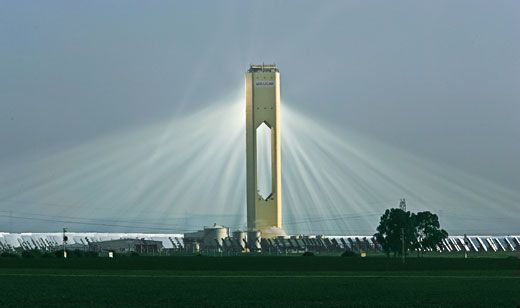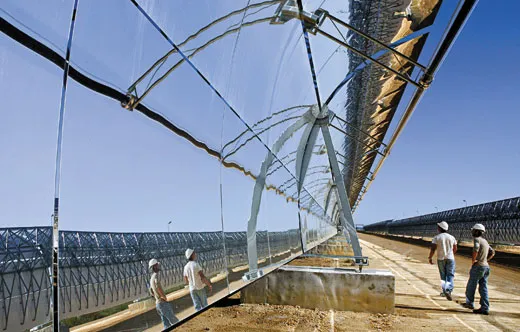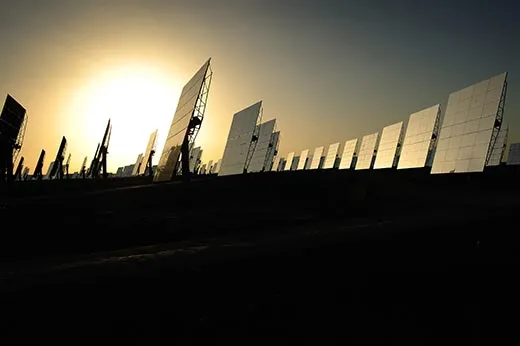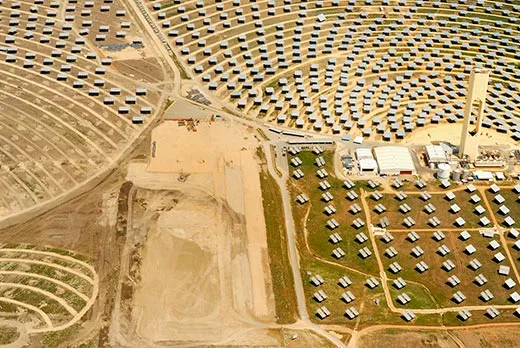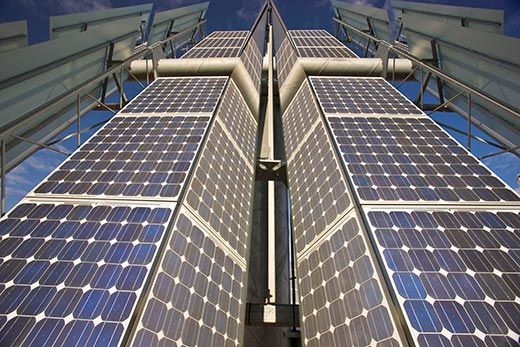A Spanish Breakthrough in Harnessing Solar Power
Solar technologies being pioneered in Spain show even greater promise for the United States
/https://tf-cmsv2-smithsonianmag-media.s3.amazonaws.com/filer/Solar-Panels-Solucar-facility-631.jpg)
Amid the green wheat fields, oak groves and ancient olive trees of Andalusia, a giant solar energy farm shimmers like a silver sea. Even under cloudy skies, the arrays of mirrors and massive towers sprawling over three square miles are an arresting sight.
Twenty miles west of Seville, the Solúcar solar farm, built by the company Abengoa, is part of Spain’s push to produce more energy from renewable sources. The nation currently produces up to 3.65 gigawatts of power from the sun, second in the world after Germany. Those gigawatts make up about 3 percent of the country’s power, the highest percentage in the world. (The United States generates less than 1 percent of its energy from the sun.) Spain’s solar output is expected to rise in the next three years to seven gigawatts, enough to supply about ten million people—the combined population of Madrid and Barcelona—with electricity during the day.
The Solúcar farm is pioneering technologies that are being replicated in the United States, including concentrated solar power, or CSP. While traditional solar panels use photovoltaic cells to convert the sun’s rays directly into electricity, CSP deploys huge banks of mirrors to focus solar radiation; the intense heat drives steam turbines, producing electricity in a process similar to the one used in coal-or oil-fired plants, but without the greenhouse gas emissions.
At the Solúcar site, two concrete towers—one about 50 stories tall, the other 35—collect light reflected by 1,879 enormous glass mirrors, each one 33 feet high and 40 feet wide. The mirrors, called heliostats, cover some 345 acres. They face south and are turned to follow the sun as it crosses the sky.
The smaller CSP tower began providing power in 2007, the larger one in May 2009. Together, they produce 31 megawatts. By 2013, when Solúcar is finished adding another tower plant and other installations, Abengoa expects the CSP facility to generate 300 megawatts, enough energy to power 220,000 households, or all of metropolitan Seville.
“These commercial tower plants are unique in the world,” Valerio Fernández, Solúcar’s operations manager, told me in his office overlooking the mirrored fields. (He was not counting a small, five-megawatt power tower operated in Lancaster, California, by the American company eSolar, or a demonstration tower the Spanish government runs in Almería.) “Today, however, they’re on vacation,” he added, with a shrug.
When it’s raining or overcast—like the cool gray March day I visited—the solar installation shuts down. But photographs of the CSP site at its best are otherworldly: towers glowing with shafts of light, an effect caused by reflected sunlight passing through water vapor and dust in the air. Though you might think the south of Spain is an ideal solar energy site, Fernández said the company expects bad weather to reduce or halt energy production around 80 days a year, generally between November and March.
“If we are seeking to make solar power more efficient, there are better places than Seville,” Fernández told me. He gestured to a wall map of the world with shaded bands representing solar energy potential: Andalusia was tan, the Mojave Desert of California and Nevada brown, and the Sahara darker still.
“The Mojave has about 30 percent higher solar radiation than we have here, so installing the same plants there will reduce the cost of electricity by 30 percent,” he said. Efficiency is even higher for the scorching Sahara, where Abengoa and Desertec, a European consortium, aim to build solar facilities that will deliver power to Europe through cables beneath the Mediterranean.
Fernández hefted a three-inch-wide piece of steel pipe off a bookshelf and handed it to me. It was from a tube in which water is converted to steam atop a CSP tower, and it had been painted black. “The blacker they are,” he explained, “the better they absorb radiation.”
The heliostats concentrate solar radiation so effectively that temperatures on the surface of the receiver tubes could potentially reach 3,600 degrees Fahrenheit, about one-third of the sun’s surface temperature. “Unfortunately, the steel would melt and the receiver would break down,” Fernández said dryly. Ceramic materials could perhaps withstand such heat, he went on, but they haven’t yet been developed and tested. So on bright days plant operators adjust the heliostats to limit the sunlight directed at the towers and maintain the temperature around 570 degrees—plenty hot to make steam out of water, which boils at 212 degrees.
As Fernández drove me around Solúcar’s campus, we stopped at the construction site for Solnova 1, the first of five planned CSP facilities here to use so-called parabolic trough technology. Solnova 1 will deploy mirrors shaped like shallow troughs, each several hundred yards long and about two yards high, in parallel rows like ranks of immense shiny ribbons. At the focal point of each mirror will run a transparent tube filled with a synthetic oil. The mirrors will direct sunlight to the tubes, and the heated oil will be used to boil water for turbine-driving steam.
Leaving Solnova 1, I caught sight of a vast array of photovoltaic panels. Although the panels supply around three megawatts of electricity—enough to power 2,200 households—Solúcar has not emphasized photovoltaics. “Photovoltaics are not leading to a technology that can store energy except in batteries,” Fernández said. That is too costly.
A more efficient storage system is on display at Solúcar’s TES (for Thermal Energy Storage) facility, which uses concentrated solar power to heat huge containers of molten salts, chiefly sodium and potassium nitrates, to some 570 degrees. The salts retain heat for up to six hours, meaning that it can be released after the sun goes down. This storage method could solve, at least partially, solar energy’s toughest challenge: providing power at night.
Spain’s booming solar capacity has depended on hefty government support. (CSP plants, for example, cost about twice as much to build and operate as conventional coal-fired plants.) The Spanish government’s subsidy to solar energy providers—among the world’s most generous—is running to more than €1.5 billion, or almost $1.9 billion, a year.
In the United States, federal and state governments are providing smaller financial incentives to individuals, solar power firms and utilities. Parabolic trough facilities in California and Nevada already generate more than 370 megawatts, and Abengoa is planning a 282-megawatt plant using similar technology near Phoenix, said Reese Tisdale, solar research director for Emerging Energy Research in Cambridge, Massachusetts. New parabolic trough, photovoltaic and CSP plants are proposed in California, Nevada, New Mexico, Colorado, North Carolina and Florida.
One massive solar farm, using towers and heliostats and promising to generate 392 megawatts of power, is slated for construction in, yes, the Mojave Desert in Southern California, if it passes state and federal environmental reviews.
“If you want to be optimistic,” Tisdale said, “there could be as much as eight gigawatts supplied by solar power plants [in the United States] by 2025.” That would be enough to power a U.S. city of six million (Americans use more electricity than Spaniards) and save 37,260 barrels of oil or 11,000 tons of coal a day.
Richard Covington writes from his home near Paris.
